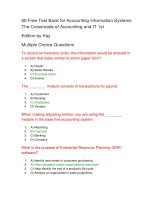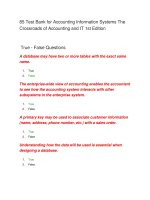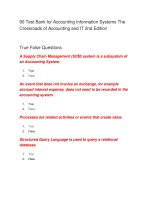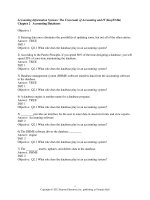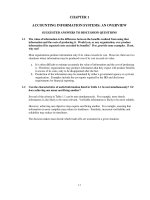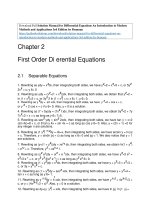Solution manual for accounting information systems the crossroads of accounting and IT 1st edition by kay sample
Bạn đang xem bản rút gọn của tài liệu. Xem và tải ngay bản đầy đủ của tài liệu tại đây (439.21 KB, 14 trang )
Active Review
1.1 Refer to the chapter opener, “Meet Business Intelligence.” In your opinion, how can business
intelligence create value using the accounting system?
Download full Solution Manual for Accounting Information Systems The
Crossroads of Accounting and IT 1st Edition by Kay at
/>Students’ opinion may differ. However, their opinion should include: Increase profitability, improve
customer relationship, increase sales by targeting the right customer category, and in general improving all
aspects of business activities.
1.2 Refer to the chapter opener, “Meet Business Intelligence.” Discuss the importance of sales data in
creating business intelligence for an organization.
Business Intelligence allows the organization to continuously monitor their sales transactions. By
monitoring sales, the enterprise can fine-tune other business processes such as purchasing, production,
advertising, and customer service.
1.3 Pick your favorite Accounting Insight from Chapter 1. Discuss why it’s your favorite.
The answer to this question depends on the student selection and his/her reason for selecting it.
1.4 What are the modules in the baseline accounting system model? Discuss the purposes and transactions
associated with each module.
1. Vendors. This module encapsulates all data and business processes related to vendors. The transactions
associated with Vendors module are: Create purchase Order, Receive Items, and Enter Bills.
2. Customers. This module encapsulates all data and business processes related to customers. The processes
associated with Customers module are: Create Invoice, and Receive Customer Payments.
3. Employees. This module encapsulates all data and business processes related to employees. The processes
associated with Vendor module are: Enter Time and Calculate Payroll.
4. Banking. This module encapsulates all data and business processes related to organization banking. The
processes associated with Banking module are: Pay Bills, Make Deposit, Pay Employees, and Pay Payroll
Liabilities.
5. Financials. This module encapsulates all data and business processes related to the organization financials.
The processes associated with Financial module are: Adjusting Entries, Correcting Entries, Closing, and
ad-hoc financial activities.
6. Reports. This module encapsulates all data and business processes related to the accounting reports. The
processes associated with Reports module are: Management Reports, Tax Reports, External Financial
Reports, and Sustainability Reports.
1.5 What elements of a database do you see when you look at a spreadsheet worksheet? Discuss how the
features of a spreadsheet and a database are similar and how they are different.
A spreadsheet shows rows and columns of a table and that is same as a database table records and fields
features. Actually, a spreadsheet row is a record and a column is a field in a database table. A database is
three dimensional in that it can store multiple tables that can be interrelated.
1.6 Discuss the potential risks if a company’s accounting system is not well secured.
Unauthorized access to the accounting data and software could result in valuable information being stolen
or damaged. Additional virus or other malicious software damage to accounting systems software may
occur
1.7 Discuss the benefits of an integrated enterprise system.
An Integrated enterprise system allows data being shared among various enterprise departments. For
example, advertising department can use data collected about sales to cluster customers into categories and
target customers-categories with different adverting methods.
1.8 Discuss how value chain activities are related to accounting transaction cycles.
The value chain facilitates coordination of activities with suppliers and customers, including purchasing
and sales transactions.
1.9 Discuss the significance of information technology to the accounting professional.
Today, most accounting systems are computerized systems. These accounting systems are installed on the
enterprise computers and used on the enterprise internal networks as well as the Internet. To effectively
work with computers and use accounting systems, accountants must know enough about computers and
networks to be able to use computerized accounting systems.
1.10 Discuss problems that enterprises may experience with shadow data.
Two major problems experienced by enterprises with shadow data are lack of documentation and
inadequate security and control.
Key Terms Check
1.11 Match the following terms and definitions.
1.12
Match the
following terms and definitions.
a. enterprise
system
a.
module
b. vendors
integrated
enterprise system
b.
customers
module
c. business
processes
c.
employees
d. value chainmodule
d.
banking module
e. transaction
cycles
e.
financial
module
f. purchasing
cycle
f.
g. reports
payroll module
cycle
g.
h. adjusting
sales cycleentries
h.
correcting
entries system
i. baseline
accounting
i. closing entries
j. financial reports
k. tax reports
l. management reports
m. sustainability reports
_d_1. An organizing framework for business processes,
_f__ 1. Abeginning
module that
to and
output
fromwith
the accounting
withrelates
vendors
ending
customers
system. or transactions between an enterprise and
_h_2. Exchanges
_e__ 2. its
A module
that includes adjusting and correcting
customers
entries. transactions related to specific business
_e_3. Accounting
_a__ 3. processes
A module related to purchasing goods and
services.
_b_4. Shares data across functional areas within the
_d__ 4. enterprise
A module that involves cash received and cash
paid.
_g_5. Transactions with employees
_c__ 5. A module related to the payroll cycle.
_c_
6. Related activities performed by an enterprise to
_b__ 6. A module related to selling the customer a product
create value by transforming input into output
or service.
_a_
7.
A
system used
that supports
business
activities
_m_ 7. Reports
to evaluate
an enterprise’s
throughout
the
enterprise,
including
inputs,
sustainability performance.
processing,
and
outputs
_k__ 8. Reports used when filing federal, state, and local
_f_8. Transactions
related to purchasing items from
returns.
vendors
_l__ 9. Reports prepared to assist managers in making
_i_9. Adecisions.
model that provides an enterprise-wide view of the
firm’s
accounting
system
_j__ 10. Reports
that include
a company’s income
statement, balance sheet, and statement of cash
flows.
_g__ 11. Entries to bring accounts up to date at year end.
_i__ 12. Zeros out income and expense accounts at year
end.
_h__ 13. Entries to correct errors.
1.13 Match the following terms and definitions.
a. field
b. record
c. primary key
d. relational database
e. operational database
f. business intelligence
g. OLAP cubes
1.14 Match the following terms and definitions.
a. people
b. processes
c. technology
d. information technology (IT)
e. IT architecture
f. IT infrastructure
g. system development life cycle (SDLC)
h. plan
i. analyze
j. design
k. build/buy
l. install
m. deploy
_c__ 1. A unique identifier for each record.
_g__ 2. An online application that permits users to view
data in a multidimensional way.
_b__ 3. A collection of related database fields.
_f__ 4.Data analytics and predictive modeling used to gain
insights from data to improve the quality of
business decisions.
_a__ 5. A piece of information.
_e__ 6. A database that stores transactions related to
business operations.
_d__ 7. A collection of related database tables.
_g__ 1. A framework for organizing the complex,
multifaceted undertaking of developing a system.
_k__ 2. Includes testing databases and computer programs
for the new system.
_h__ 3. Includes scheduling, budgeting, and staffing a
project.
_i__ 4. Includes evaluating new system requirements.
_m_ 5. Using the new system on an ongoing basis and
maintaining and updating it as necessary.
_l__ 6. Setting up new IT hardware, software, and
databases.
_j__ 7. Prepare models for business processes and
databases for the new system.
_b__ 8. One of the three keys of opportunity that focuses
on how business activities are impacted.
_c__ 9. One of the three keys of opportunity that focuses
on software, hardware, and networks.
_a__ 10. One of the three keys of opportunity that focuses
on how employees, customers, and vendors are
impacted.
_d__ 11. Consists of software, hardware, and network
technology used by an organization.
_f__ 12. How specific software, hardware and networks
are used to build IT architecture for an enterprise.
_e__ 13. The design or blueprint for an enterprise’s
information technology.
Exercises
Short Exercises
1.15 Match each of the following accounting events to the baseline accounting system module in which it
occurs. (Q1.3)
Vendors module
Customers module
Employees module
Banking module
Financial module
Reports module
1. Create purchase orders __Vendors module__________
2. Adjusting entries ____Financial module________
3. Make deposits ____Banking module________
4. Calculate payroll ____Employees module________
5. Receive customer payments ____ Customer module________
6. Pay bills ___Banking module_________
7. Tax reports ___Reports module_________
8. Enter time ____Employees module________
9. Enter bills ___Vendors module_________
10. Create invoices __Customers module__________
11. Pay employees ____Banking module________
12. Receive items ____Vendors module________
13. Sustainability reports ___Reports module_________
14. Pay payroll liabilities ____Banking module________
15. Correcting entries ____Financial module________
16. Management reports ___Reports module_________
17. Closing ___Financial module_________
18. Financial reports ___Reports module_________
1.16 Match each of the following accounting events to the accounting transaction cycle.
(Q1.3)
Purchasing cycle
Sales cycle
Payroll cycle
1. Create purchase orders ___Purchasing cycle_________
2. Create invoices ____Sales cycle________
3. Make deposits ___ Sales cycle_________
4. Calculate payroll ___Payroll cycle_________
5. Receive customer payments __Sales cycle__________
6. Pay bills ___Purchasing cycle_________
7. Enter time ___Payroll cycle_________
8. Enter bills ___Purchasing cycle_________
9. Receive items __Purchasing cycle__________
10. Pay employees __Payroll cycle__________
1.17 Identify which of the following are internal agents to an enterprise and which are external agents.
(Q1.4)
1. Vendors
2. Customers
3. Employees
4. Delivery service
5. Internal Revenue Service
6. Bank
External: Vendor, Delivery service, Internal Revenue Service, and Bank
Internal: Employee
1.18 Can you match the following terms used by accounting professionals and those used by IT
professionals?
(Q1.1)
a. Rows
b. Columns
c. Software
_c__ 1. Applications
_a__ 2. Records
_b__ 3. Fields
1.19 Match each of the following transaction cycles to the integrated enterprise system module that
generates the transactions.
(Q1.2)
a. Purchasing cycle
b. Payroll cycle
c. Sales cycle
_b__ 1. Human resources management (HRM)
_a__ 2. Supply chain management (SCM)
_c__ 3. Customer relationship management (CRM)
_b__ 4. Operation/production system (OPS)
1.20 Look at the CUSTOMER table for EspressoCoffee appearing in Figure 1.12. Can you answer the
following questions? (Q1.3)
1. How many fields do you see in the database table in Figure 1.12?
2. How many records do you see in the database table?
3. Are there any other fields that you would recommend that EspressoCoffee add to the
CUSTOMER table? Is there any additional information that EspressoCoffee might need about customers?
1. 8
2. 2
3. For every additional piece of information, an additional field must be added to the table in figure 1.12.
Few of these additional pieces of information are: customer’s email addresses, country, and phone
numbers
1.21 For the following functions of the accounting system, identify technologies used by each function.
(Q1.3)
1. 1. Storing accounting data: Relational database
2. Analyzing accounting data: Business analytics
3. Safeguarding accounting data: checking user ID and password
1.22 Using the three keys of opportunity, identify the impact of an enterprise changing accounting
software on people, processes, and technology. (Q1.4)
The answer to this question depends on the current type of the enterprise accounting system and the new
system. A few impact of the change is listed below:
1. People: accounting employee should learn how to use the new system since some employees may lose
their job or new employees get hired and need training.
2. Processes: change in the workflow may lead to manual accounting activities becoming increasingly
automated.
3. Technology: Data migration into the new system’s database. Addition of new hardware such as
computers, network routers might be necessary.
It’s Your Call
1.23 Your firm has announced that in order to meet earnings targets, 10% of its workforce must be let go.
As chief financial officer you have been asked to explain the value that your staff of accounting and IT
professionals provide to the firm. You realize that your response may affect the number of staff that you
keep employed. What would you say? (Q1.1)
Your response may show the proper IT knowledge of your accounting staff and how this facilitates
communication between your IT and accounting staffs. Also it could indicate that accountants and IT
professionals who need to work together and communicate well underscores the need for accountants who
understand accounting and IT.
In conclusion, you can emphasize how this seamless communication could reduce the cost of accounting
projects and their risk of failure.
1.24 You are working as an intern in the payroll department of a large company. Your best friend, who
helped you get the job, works at the same company in sales. Your friend calls you when he is traveling and
says his login for the system is not working. IT told him it might take up to 24 hours to fix it. He asks you
to share your login with him so he can access the system. What would you do? (Q1.3)
Under no circumstances you should share confidential information with person or persons who don’t have
the authorization for that confidential information. You are the only one who is allowed to know your login
and password information. Organizations are very strict about this rule.
1.25 To meet a tight deadline, you download spreadsheet files to your company laptop to take work home
with you. What are the risks to safeguarding the information on your laptop? (Q1.3)
When an organization secured and sensitive data is copied or moved into portable device (for example a
laptop), then the organization data is available for whoever steals that device. Also, since data is outside of
the organization’s secured network it can more, easily be accessed by a computer hacker.
1.26 Your younger brother calls you from college. He is registering for classes. He wants to know why he
needs to take an accounting information systems course. How will the course help him to be successful in his
future career? What do you tell him? (Q1.3)
Most organization accounting data is stored in databases. These databases reside in the database servers and
can be accessed and manipulated by using computer applications. The accounting information systems
course provides the required knowledge and skills to accountants to find their way at the crossroad of
accounting and IT. The knowledge and skills include:
1. Computerized accounting transactions
2. Proper IT concepts and applications
Tech in Practice
Tech Exercises
1.27
Tech Tool: Spreadsheet Software
Software Video: Spreadsheet Data Tables
EspressoCoffee has given you the following work assignment.
1. Using spreadsheet software and the following information, create a CUSTOMER table for EspressoCoffee.
2. Identify the primary key by highlighting the column in yellow.
3. Populate the CUSTOMER table by entering the following customer information.
Customer No.: 127127
Name: Angela Ashuer
Address: 13 Joseph Ave, Appleton, WI, 54911
Customer No.: 913691
Name: Vincent Pico, EspressoBar
Address: 58 Dante, Pisa, Tuscany, 56100
Customer No.: 127000
Name: Becky Cornell
Address: 1203 N Lake Shore Drive, Chicago, IL 60610
Customer No.: 1958361
Name: David Kolse, Creamy Coffee
Address: 702 Ensenada Street, Orlando, FL 32825
Customer No.: 532700
Name: Fred Olhman, Coffee Shoppe
Address: 7011 Second Street, San Francisco, CA 94102
See Tech Ex1.27 SOLUTION in the Chapter 1 Exercises Solutions folder
1.28
Tech Tool: Database Software
Software Video: Database Tables
EspressoCoffee has given you an assignment to create a database table for tracking customer information.
1. Using Microsoft Access database software and the following fields, create a C USTOMER table for
EspressoCoffee
Customer No.
Last Name
First Name
Company Name
Street Address
City
State
ZIP
Country
Email Address
Web Site
2. Using Microsoft Access, select the primary key for the CUSTOMER table.
3. Populate the CUSTOMER table by entering the following customer information.
Customer No.: 127127
Name: Angela Ashuer
Address: 13 Joseph Ave, Appleton, WI, 54911, USA
Email:
Customer No.: 913691
Name: Vincent Pico, EspressoBar
Address: 58 Dante, Pisa, Tuscany, 56100, Italy
Email:
Web site: espressobar.it
Customer No.: 127000
Name: Becky Cornell
Address: 1203 N Lake Shore Drive, Chicago, IL 60610, USA
Customer No.: 1958361
Name: David Kolse,
Creamy Coffee
Address: 702 Ensenada Street, Orlando, FL 32825, USA
Email:
Web site: creamycoffee.com
Customer No.: 532700
Name: Fred Olhman,
Coffee Shoppe
Address: 7011 Second Street, San Francisco, CA 94102, USA
Email:
Web site: coffeeshoppe.com
See Tech Ex1.28 SOLUTION in the Chapter 1 Exercises Solutions folder
1.29
Tech Tool: Database Software
Software Video: Database Tables
EspressoCoffee has asked you to create an ORDER database table.
1. Using Microsoft Access database software and the following fields, create an O RDER table for
EspressoCoffee.
Order No.
Date
Customer No.
2. Using Microsoft Access, select the primary key for the ORDER table.
3. Populate the ORDER table by entering the following information for three orders.
Order No.: 5819
Date: 12.21.2010
Customer No.: 127127
Order No.: 5820
Date: 12.23.2010
Customer No.: 913691
Order No.: 7200
Date: 07.01.2011
Customer No.: 127000
Order No.: 9723
Date: 12.21.2012
Customer No.: 1958361
Order No.: 12631
Date: 12.27.2013
Customer No.: 1958361
See Tech Ex1.28 SOLUTION in the Chapter 1 Exercises Solutions folder
The ORDER table is already created in the Tech Ex 1.28 SOLUTION file
1.30
Tech Tool: Spreadsheet Software
Software Video: Spreadsheet Data Tables
1. Using spreadsheet software, construct a table that will collect data for an application of your choice
(for example, data regarding dogs for a dog walking business).
2. Identify the appropriate fields.
3. Identify the primary key.
4. Populate at least two records with test data.
The answer to this question depends on the student choice of the business.
1.31
Tech Tool: Database Software
Software Video: Database Tables
1. Select an authentic enterprise of your choice. Using Microsoft Access database software, develop a
CUSTOMER table for the enterprise, identifying the appropriate fields.
2. Using Microsoft Access, select the primary key for the CUSTOMER table.
3. Populate the CUSTOMER table by entering test data for at least three customers.
4. What customer reports would the enterprise need to create? Would the database table you created be
able to provide the information required?
The answer to this question depends on the student choice of the business. However, the answer is similar
to the Tech Ex 1.28
1.32 (Continuation of TIP 1.31)
Tech Tool: Database Software
Software Video: Database Tables
1. Using Microsoft Access database software and information from the prior exercise, create an O RDER
table, identifying the appropriate fields.
2. Using Microsoft Access, select the primary key for the ORDER table.
3. Populate the ORDER table by entering test data for three orders.
4. What queries can you envision that the enterprise might need that would use information from both the
CUSTOMER table and the ORDER table?
The answer to this question depends on the student choice of the business. However, the answer is similar
to the Tech Ex 1.28 and Tech Ex 1.29 combined
1.33
Tech Tool: Database Software
Software Video: Database Tables
1. Download the Tech Ex 1.33.accdb in the Chapter 1 Exercises Solutions folder for this exercise.
2. Open the Microsoft Access database file.
3. How many tables exist in the database? Four tables
4. How many records are in the CUSTOMER table? There are 2 records in the CUSTOMER table
5. What is the primary key in the CUSTOMER table? CUSTOMER NO is the primary key in the
CUSTOMER table
6. What field in the CUSTOMER table connects it to the ORDER table? Customer NO in the CUSTOMER
table and CUSTOMER NO on the ORDER table
Go Online
1.34 You have decided to start your career planning. Your first step is to go online and search for job
openings for entry-level accounting professionals. What skills and competencies do the job openings
require? Compare the requirements with your current status. How do you plan to gain the skills and
knowledge needed?
The answer to this question depends on the search results. One possible result could be the following table.
As you notice the level of computer knowledge is ranked high to very high.
Skill
People skills
Sales skills
Communication skills
Analytical skills
Ability to synthesize
Creative ability
Initiative
Computer skills
Work hours
Audit Accounting
Medium
Medium
Medium
High
Medium
Low
Medium
High
40-70/week
Tax & Financial
Medium
Medium
Medium
Very High
Low
Medium
Medium
High
40-70/week
Management Accounting
Medium
Low
High
High
High
Medium
Medium
Very High
40-50/week
1.35 You have been in your current accounting position for five years. You want to continue advancing in
your career. Go online and search for your ideal accounting professional position five years after you
graduate from college. What are the positions that you would apply for? What skills and competencies do
the job openings require? Compare the requirements with your current status. How do you plan to gain the
skills and knowledge needed?
The answer to this question depends on the search results. One possible result could be the following job
requirements posted for a senior accounts payable specialist. Its requirements include a BS in accounting an
5 to 7 years of experience. Notice that the knowledge of SAP is a must!
Knowledge and Abilities
5 to 7 years related experience and/or training; or equivalent combination of education and experience.
Strong Accounting knowledge in Accounts Payable and General Ledger Strong SAP experience is a must
Ability to operate a telephone, fax machine, calculator, copier, scanner, and other non-specified office
equipment a computer with the following software: Microsoft Office: Word, Excel, Outlook, and
PowerPoint; Lotus Notes, Tiny Terms, FoxPro Forwards, and other proprietary software Written and verbal
fluency in English Ability to read and interpret documents such as operating instructions, procedure
manuals, and financial statements; to write routine reports and correspondence; to speak effectively before
groups of customers or employees of organization. The applicant must have the:
Ability to perform numerous data-entry task and multi-tasks Ability to focus and pay attention on
details Ability to calculate figures and amounts.
Ability to apply common sense understanding to carry out instructions furnished in written, oral, or
diagram form such as simple AP procedures and datelines.
Ability to deal with problems involving several concrete variables in standardized situations.
Ability to deliver good customer service when handling vendors’ inquiries and assisting employees
and clients.
Ability to maintain invoices and other documentations in an organized manner Industry knowledge of
accounting in oil and gas industry.
1.36 You have been asked by the CFO to prepare a brief presentation to management about how business
intelligence could benefit your company. Go online to research how other companies are using business
intelligence. Prepare a brief presentation as requested by the CFO.
The answer to this question depends on the search results. However, when business intelligence is properly
implemented and used, delivers many benefits. The key benefits include the following:
1. Alignment of an organization around a consistent set of Key Performance Indicators (KPIs) and
Metrics
2. Quicker, fact-based decision making
3. Simplified graphical presentation of KPIs and metrics
4. Reliable presentation of information (‘One version of the truth’)
5. Combination of multiple data sources (ERP, CRM, Spreadsheets, Budgets...)
6. Faster collection and dissemination of information
(Source link: />1.37 You are working for a business solutions consulting company that hired you because of your
knowledge of accounting systems and IT. You have been asked to select the two accounting software
applications that you believe have the best features. Go online and search for two accounting software
applications commercially available. Identify whether the software is predominantly used by small,
midsize, or large enterprises. List the features these products offer to customers. Briefly summarize the
advantages and disadvantages of each and why these two are your top picks.
Students could compare accounting software based on the following:
1. Eased of use
2. Help and support
3. Offered accounting modules (that is account receivable, account payable, payroll, etc)
4. Cost
5. Flexibility of use with other software and operating systems
The following link to the Top Ten Review could be helpful for small size enterprise.
/>1.38 Your accounting colleagues are debating the differences between data, information, and business
intelligence. Go online and search for definitions of data, information, and business intelligence. Construct
your own definition for each that you like best that you can share with your colleagues.
The following could be a possible definition for data, information, and intelligence in the business context:
1. Data is a collection of facts, figures and statistics related to an object. for example customers fill an
sales order form. The sales order form consists of facts (data) about customers (for example customer
name), and the sales order event (for example sales order date).
2. Information is the manipulated and processed form of data. It is interpreted data. For example a graph
showing a customer average sales order in dollar amount.
3. Business intelligence refers to computer-based methods and techniques used to find meaningful
relationship among business facts, such as sales amount and product type.
Technology Projects
Technology Project 1
Tech Tool: Spreadsheet Software, Database Software
Software Videos: Spreadsheet Data Tables, Database Tables
iSportDesign, an online retailer of sporting goods that the customer can custom design, needs help in
modernizing its accounting system. Nick, the owner and operator, has asked for your assistance. He wants
to hire you as an intern. This is your opportunity to get some experience with accounting and technology,
so you agree.
The first project he has for you is putting customer data into electronic form for easier retrieval. You decide
to put the customer data into both a spreadsheet and a database so Nick can choose which he likes best for
his company.
Your deliverables for the project include the following:
Deliverable 1. A spreadsheet containing customer data for iSportDesign
Deliverable 2. A CUSTOMER database table
Visit iAccount.me to do the following:
1. Download Technology Project 1 instructions.
2. Download files provided online for your convenience in completing the project deliverables.
3. Watch the videos with software instructions to complete this project at iAccount.me.
See Project CHAPTER1SOLUTION (MS Access) file and Project Chapter1SOLUTION (MS Excel) file in
the Chapter 1 Exercises Solutions folder.
